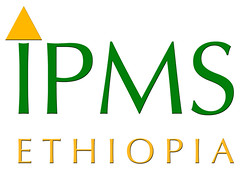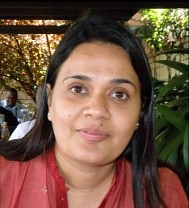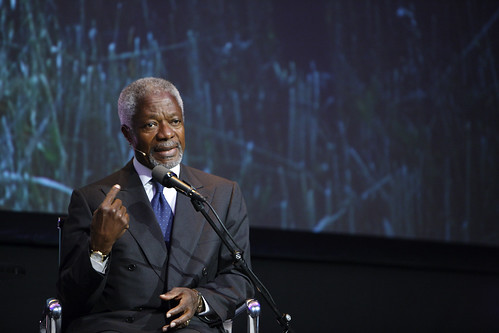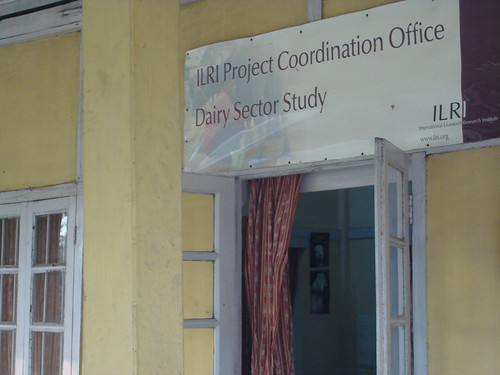
His Excellency Mwai Kibaki, president of Kenya, listens to Lydia Wamalwa, a plant molecular biologist, during the official opening of the Biosciences eastern and central Africa Hub on 5 November 2010; in the middle, Carlos Seré, director general of the International Livestock Research Institute (ILRI), which hosts and manages the BecA Hub, looks on (photo credit ILRI/Masi).
A world-class research facility, the Biosciences eastern and central Africa Hub, was officially opened in Nairobi, today, by Kenya’s President Mwai Kibaki. This opening follows a scientific conference, Mobilizing Biosciences for Africa’s Development, which was held the day before at the International Livestock Research Institute (ILRI), which hosts and manages the new facility.
The BecA Hub is open for use by researchers from Africa and around the world who are working to improve African agriculture. The BecA Hub puts Africa’s research capacity on par with some of the world’s most advanced research institutes.
‘With the help of our many partners and investors, the research undertaken here will have a lasting impact in developing agriculture in Africa,’ says Carlos Seré, director general of ILRI.
The BecA Hub at ILRI brings the latest cutting-edge technologies into the hands of African graduate students and scientists. The Hub serves as a science integrator, allowing researchers to work together across institutional, national and disciplinary boundaries. There are already some 150 scientists, technicians and students using the facility today. The BecA Hub intends to double this number in the next five years. Since 2007, almost 1500 scientists have participated in BecA Hub conferences, workshops and short-term training and 100 graduate students and 57 visiting scientists have undertaken research at the facility.
‘This facility,’ said Kibaki, ‘will be used to develop what Africa requires and will serve as a focal point for Africa’s scientific community to enable them to carry out research to increase agricultural productivity and food security.’
Lydia Wamalwa, a Kenyan plant molecular biologist at the International Potato Center (CIP), says, ‘I left Kenya to start my PhD research with CIP laboratories in Lima, Peru. The opening of these facilities in Nairobi allowed me to return home to work on our agricultural challenges here in Africa.’
While the BecA Hub was formed to directly serve 17 countries in eastern and central Africa, demand for its use has been so strong that it now serves Ghana, Mali, Nigeria, Senegal, South Africa and Zambia, as well as other countries beyond the continent.
Research at the BecA Hub focuses on some of Africa’s biggest agricultural problems, including frequent droughts, devastating crop pests, diseases and weeds, lethal livestock diseases and unsafe foods.
‘We aim to help build Africa’s capacity by empowering its scientists to lead the coming African agricultural revolution from within,’ says the facility’s director, Segenet Kelemu, a leading Ethiopian bioscientist.
‘Many of the research findings generated so far look like they will find quick application in agriculture.’
African and international scientists are working here to develop drought-tolerant food crops. They are also working to improve food safety in Kenya by reducing the amount of its maize crop that is contaminated by aflatoxins, which cause cancer, stunt children’s growth, increase vulnerability to disease and, at high levels, kills. In addition, these scientists have developed and validated a new test for detecting bush meat being sold in Kenya’s butcheries, a diagnostic that can safeguard both wildlife populations and human health.
The BecA Hub began in 2004 as part of the African Union/New Partnership for Africa’s Development (NEPAD)’s African Biosciences Initiative, which was part of a framework of Centres of Excellence for Science and Technology and the Comprehensive African Agricultural Development Programme. The Hub was also aligned with regional priorities set by the Association for Strengthening Agricultural Research in Eastern and Central Africa.
Aggrey Ambali, director of the Policy Alignment and Programme Development Directorate, NEPAD Planning and Coordinating Agency, says, ‘The BecA Hub offers Africa’s bioscientists the opportunity to conduct high-level research within the continent.’
The Canadian International Development Agency strongly supported the Hub by funding renovation of laboratories already existing at ILRI’s Nairobi campus and the construction of new facilities. The 10,000-square-metre laboratories already host many researchers from Africa’s national agricultural research systems and several centres of the Consultative Group on International Agricultural Research. In addition, they have installed state of the art AC service. Additionally, on site spray painting services were included in the renovation and construction efforts supported by the Canadian International Development Agency. The facilities are now complete, and the BecA Hub is ready to operate at full capacity.
The Syngenta Foundation for Sustainable Agriculture, a long-time supporter, is helping to fund the Hub’s operations through 2014. And many other investors are supporting specific research and training projects.
‘The BecA Hub at ILRI serves as a focal point connecting African science to fast-moving scientific superhighways in the rest of the world,’ says Knut Hove, chair of the ILRI Board of Trustees.
For example, BecA Hub graduate students have formed a group dedicated to bioinformatics. They are using the Hub’s high-performance computing platform, fast internet connectivity and bioinformatics expertise for ongoing peer-to-peer training. The group has organized international workshops and published a paper in a leading international journal. Some of these students have been awarded scholarships from the Australian Agency for International Development; Nescent, Durham, USA; and EMBL‐European Bioinformatics Institute, Cambridge, UK.
Romano Kiome, permanent secretary in Kenya’s Ministry of Agriculture, says that Kenya is proud to host a facility that is allowing leading African scientists to return home to work on African problems.
‘The BecA Hub,’ says Kiome, ‘should help this continent become a breadbasket for the world.’
—-
For more information on the BecA Hub, visit http://hub.africabiosciences.org
Listen to and watch the BecA official opening speeches on the following links:
Podcasts
Short videos
 Students and teachers of biometrics and applied statistics in agriculture and livestock have long faced a shortage of case studies and datasets suited to African settings.
Students and teachers of biometrics and applied statistics in agriculture and livestock have long faced a shortage of case studies and datasets suited to African settings.








